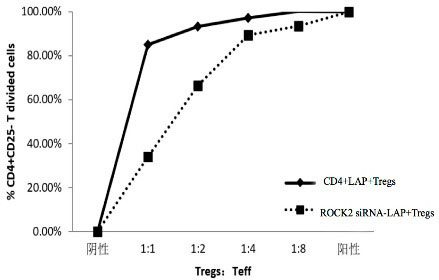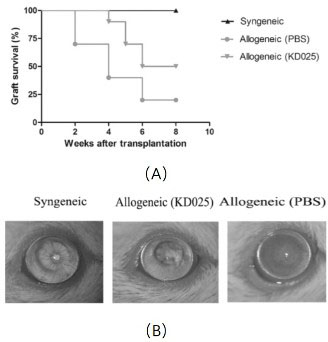Medicine for treating immunological rejection in corneal transplantation
A technology of transplant immunity and rejection, applied in the field of immunosuppression in corneal transplantation, can solve the problems of no research, no research on immune rejection inhibition, prolonging the survival time of corneal grafts, etc.
- Summary
- Abstract
- Description
- Claims
- Application Information
AI Technical Summary
Problems solved by technology
Method used
Image
Examples
Embodiment 1
[0025] Example 1: CD4 + LAP + Preparation of Tregs cells
[0026] Spleen of Balb / c mice was aseptically isolated, milled and filtered through a 200-mesh filter to prepare cell suspension. mouse CD4 + LAP + Tregs cell isolation kit to isolate CD4 + LAP + For Tregs cells, the purity of CD4+LAP+Tregs cells was analyzed by flow cytometry and the isolated CD4 + LAP + Tregs cell count. Adjust cell concentration to 1 x 10 6 / ml, add CD3 / 28 antibody beads (according to the ratio of cells and beads: 2:1) and add IL-2 with a concentration of 1000ng / ml for culture. On day 5-7 of culture, perform anti-CD4 FITC, anti-LAP PerCP-Cy5.5 staining, and use flow cytometry to sort out CD4 + LAP + Tregs cells were purified and back-tested after sorting, and the expression of LAP in the in vitro culture and expansion group could be (85.76±5.01)%.
Embodiment 2
[0027] Example 2: Construction of mouse corneal transplant rejection model
[0028] BALB / c (H-2d) mice were used as recipients, C57BL / 6 (H-2b) mice were used as donors, and both donor and recipient mice were male, 8-10 weeks old. Prepare the mouse corneal transplantation model according to the following operations, and verify the CD4 + LAP + The role of Tregs cells:
[0029] (1) Mice were anesthetized: 4% chlorine hydrate was used for intraperitoneal injection. After anesthesia, foreign objects in the oral cavity of the mice were removed and a horizontal position was maintained. During the anesthesia process, pay attention to the mouse insulation.
[0030] (2) Corneal transplantation in mice: 11-0 simple interrupted suture was used for the operation method. Preparation of implants: One hour before operation in C57 mice, the pupils were dilated with compound tropicamide, the implants were drilled with a 2.5mm drill, and the microtweezers were cut along the imprint, taking ...
Embodiment 3
[0041] Example 3: CD4 + LAP + Tregs cells in the treatment of corneal transplantation rejection in mice
[0042] After the mouse corneal transplantation operation of embodiment 3 finishes, inject 10 microliters concentration and be 5x10 to every group of mice 5 / ml CD4 prepared in Example 1 + LAP + Tregs cells; and CD4 not injected + LAP + Allogeneic keratoplasty mice with Tregs were used as controls. The results showed that injection of CD4 + LAP + In mice with Tregs cells, the survival time of the implants was significantly prolonged, compared with the control group, the average extension was 15±1.32 days.
PUM
 Login to view more
Login to view more Abstract
Description
Claims
Application Information
 Login to view more
Login to view more - R&D Engineer
- R&D Manager
- IP Professional
- Industry Leading Data Capabilities
- Powerful AI technology
- Patent DNA Extraction
Browse by: Latest US Patents, China's latest patents, Technical Efficacy Thesaurus, Application Domain, Technology Topic.
© 2024 PatSnap. All rights reserved.Legal|Privacy policy|Modern Slavery Act Transparency Statement|Sitemap



